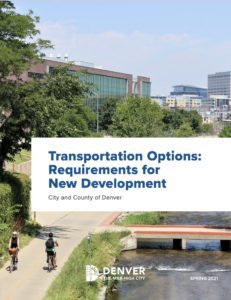After nearly two years of consideration, on Monday, April 19, 2021 the Denver City Council voted to approve a bill for a Transportation Demand Management requirement for certain new developments. The bill will amend Chapter 54 of the Denver Revised Municipal code to enable and administer a transportation demand management program for new developments.
The TDM programs in the City and County of Denver aim to:
- Reduce the number of people driving
- Create walkable, transit-friendly communities, and
- Improve community health and the environment
Developments will be required to implement a range of infrastructure, services, or programmatic tools to help residents, commuters, and visitors make greater use of biking, walking, transit, and ride-share transportation options.
Next Up: Development of Rules and Regulations

The TDM policy to expand transportation options in new developments went into effect June 1, 2021.
Prior to this, Denver’s Department of Transportation & Infrastructure (DOTI) and Community Planning and Development department (CPD) passed joint Rules and Regulations, including holding a public hearing on May 21. After passage by the Council and adoption through Rules and Regulations, the TDM policy to expand transportation options in new developments went into effect.
You can learn more about TDM and the details of Denver’s TDM program here or click the image to read the City and County of Denver’s TDM brochure, “Transportation Options: Requirements for New Developments”.
TDM policies, like this one in Denver, are part of a larger trend Wells+ Associates has seen in other jurisdictions we work in across the United States. For example, Wells + Associates has worked with similar development-based TDM requirements in places like Fairfax County, Virginia, where we have been managing TDM programs for a dozen years, and Charlotte, North Carolina, where we recently submitted the first TDM plan in that city.
In both of these regions, our work in developing and implementing plans helps ensure that properties meet their TDM requirements while enhancing the tenant experience and increasing the competitiveness of properties.

